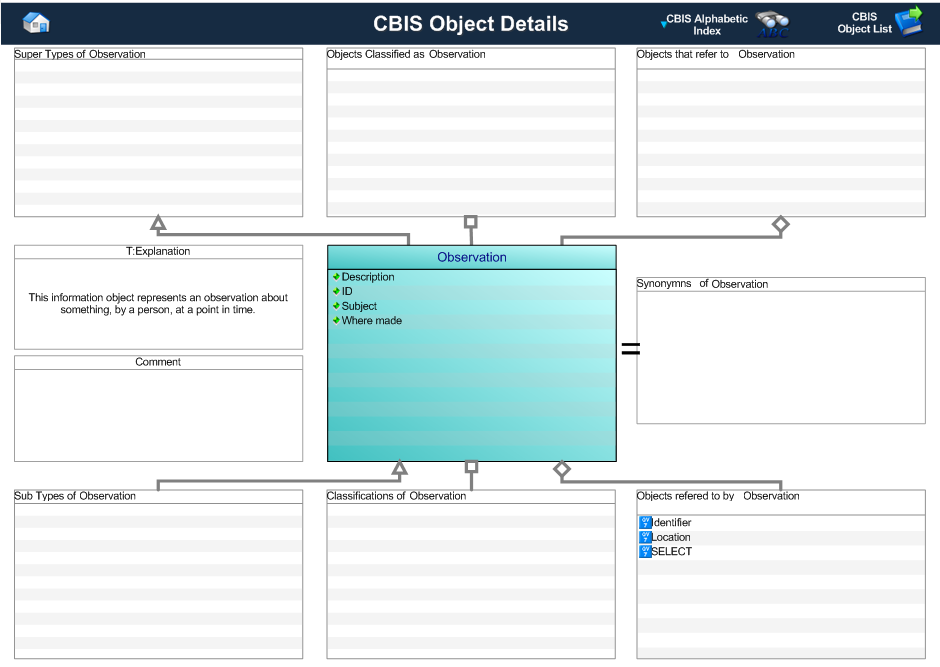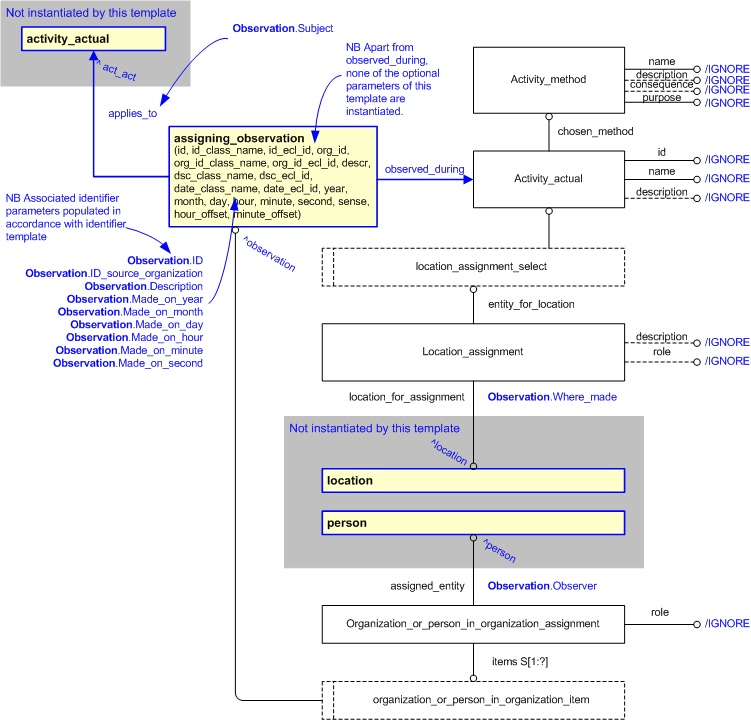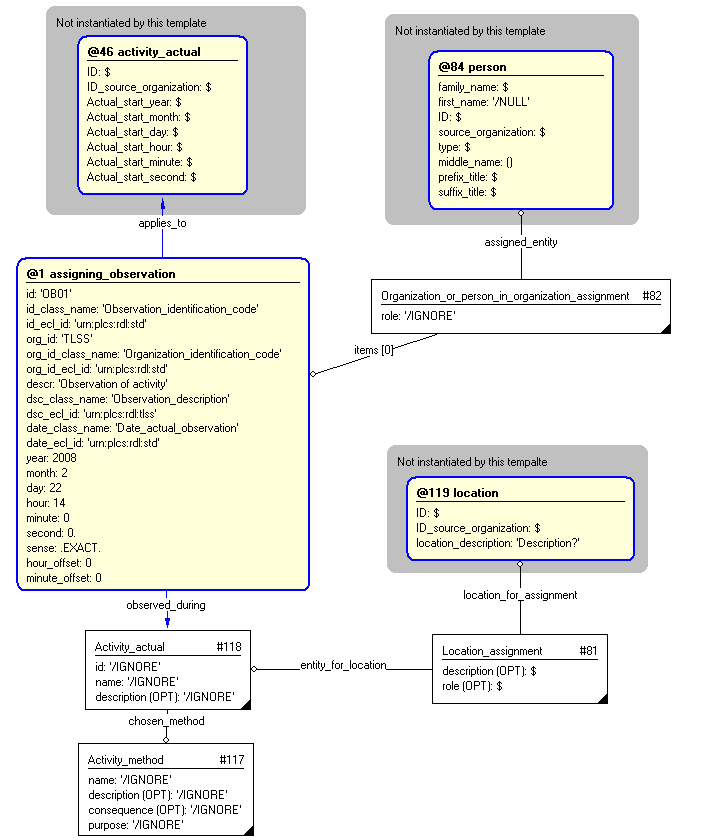Template:— observation (obs)
Context:— UK_Defence |
Date: 2009/11/03 00:53:14
Revision: 1.5
|
This section specifies the template observation.
NOTE
The template has been defined in the context of
UK_Defence.
Refer to the business context for details of related templates.
NOTE
An explanation of a template and the associated instantiation path is
provided in the
Template overview
section.
This template describes how to represent an observation about something, by a person, at a point in time.
The observation business object is used by those UK_Defence Data Exchange
Specifications that require information about the monitoring of activities or products.
Figure 1 — Graphical Representation for Business Object Observation
Observation:
The definition of an Observation object is:
Data about the monitoring of activities or products.
|
Attribute name
|
Attribute description
|
Attribute type
|
Optionality
|
| Description |
This is the description of the Observation.. |
Intrinsic |
Mandatory |
| ID |
This is the Identifier of the Observation. |
Identifier |
Mandatory |
| Subject |
This is the reference to the object that is the subject of the observation. |
SELECT |
Mandatory |
| Where_made |
This is the reference to the location at which the observation is made. |
Location |
Optional |
| Observer |
This is the reference to the person who makes the observation. |
Person |
Mandatory |
| Made on |
This is the date and time at which the observation was made. |
Intrinsic |
Mandatory |
Table 1 — Observation attribute details
The EXPRESS-G diagram in
Figure
2
shows the templates and EXPRESS entities that are required
to represent the template
"observation".
The text highlighted in blue shows the template parameters.
Figure 2 — An EXPRESS-G representation of the Information model for observation
The graphic for the template to be used in other EXPRESS-G diagrams
is shown in Figure
3
below.
Figure 3 — The graphical representation of the observation template
The following input parameters are defined for this template:
The observation identifier.
The identifier of the organization responsible for the observation identifier.
The description of the observation.
The year component of the date and time the observation was made.
The month component of the date and time the observation was made.
The day component of the date and time the observation was made.
The hour component of the date and time the observation was made.
The minute component of the date and time the observation was made.
The second component of the date and time the observation was made.
The Activity or Product that is the focus of the observation.
The person who makes the observation.
The Location at which the observation is made.
The following reference parameters are defined for this template:
Allow the
Observation
entity instantiated in this path to be referenced when this template is used.
Note: The
Observation
entity can be referenced in a template path by:
%^target = $observation.observation%
where
target
is the parameter to which the
Observation
is bound.
Allow the
Activity_actual
entity instantiated in this path to be referenced when this template is used.
%^target = $observation.observation_activity%
%^target = $observation.observation_item%
The following parameter combinations specify a uniqueness constraint:
Unique constraint: Unique id
Each instance of the
entity
(
Observation)
within the data set shall be uniquely identified
by a combination of the following parameters on this
template (observation) namely:
ID,
ID_source_organization,
Subject.
The
instance is
referenced by the following template parameter:
observation.
The instantiation path shown below specifies the entities that are to be
instantiated by the template.
A description of templates and the syntax for the instantiation path is
provided in the
Templates Help/Information section.
/
assigning_observation(
id=@ID,
id_class_name='Observation_identification_code',
id_ecl_id='urn:plcs:rdl:std',
org_id=@ID_source_organization,
org_id_class_name='Organization_identification_code',
org_id_ecl_id='urn:plcs:rdl:std',
descr=@Description,
dsc_class_name='Observation_description',
dsc_ecl_id='urn:plcs:rdl:uk_defence',
date_class_name='Date_actual_observation',
date_ecl_id='urn:plcs:rdl:std',
year=@Made_on_year,
month=@Made_on_month,
day=@Made_on_day,
hour=@Made_on_hour,
minute=@Made_on_minute,
second=@Made_on_second,
sense='exact',
hour_offset=0,
minute_offset=0,
applies_to=@Subject )/
%^observation = $assigning_observation.observation%
%^observation_item = $assigning_observation.observation_item%
-- Create relationship to observing person Organization_or_person_in_organization_assignmentOrganization_or_person_in_organization_assignment.items ->
^observation
Organization_or_person_in_organization_assignment.assigned_entity ->
@ObserverOrganization_or_person_in_organization_assignment.role = '/IGNORE'
-- Create notional observation activity so that a location may be assigned Activity_actualActivity_actual.id = '/IGNORE'
Activity_actual.name = '/IGNORE'
Activity_actual.description = '/IGNORE'
Activity_methodActivity_method.name = '/IGNORE'
Activity_method.description = '/IGNORE'
Activity_method.consequence = '/IGNORE'
Activity_method.purpose = '/IGNORE'
%^observation_activity =
Activity_actual%
-- Create relationship to location of observation Location_assignmentLocation_assignment.entity_for_location ->
^observation_activity
Location_assignment.location_for_assignment ->
@Where_madeLocation_assignment.description = '/IGNORE'
Location_assignment.role = '/IGNORE'
The following entities are instantiated with attributes as specified:
The instance diagram in Figure
4
shows an example of the EXPRESS entities and templates that are instantiated by the template:
/observation(ID='OB01', ID_source_organization='UK_Defence', Description='Observation of activity', Made_on_year='2008', Made_on_month='2', Made_on_day='22', Made_on_hour='14', Made_on_minute='0', Made_on_second='0', Subject='@49')/
(an illustration of the consolidated observation template is shown in
Figure
5 below.)
Figure 4 — Entities instantiated by observation template
The instance diagram in
Figure
5
shows the graphic symbol for the template that is to be
used in other instance diagrams. The example template is:
/observation(ID='OB01', ID_source_organization='UK_Defence', Description='Observation of activity', Made_on_year='2008', Made_on_month='2', Made_on_day='22', Made_on_hour='14', Made_on_minute='0', Made_on_second='0', Subject='@49')/
Figure 5 — Instantiation of observation template
Characterizations
No common characterizations of the template
observation
have been identified. However, the ISO 10303-239 EXPRESS model
may enable other assignments to the entities instantiated by the template.




